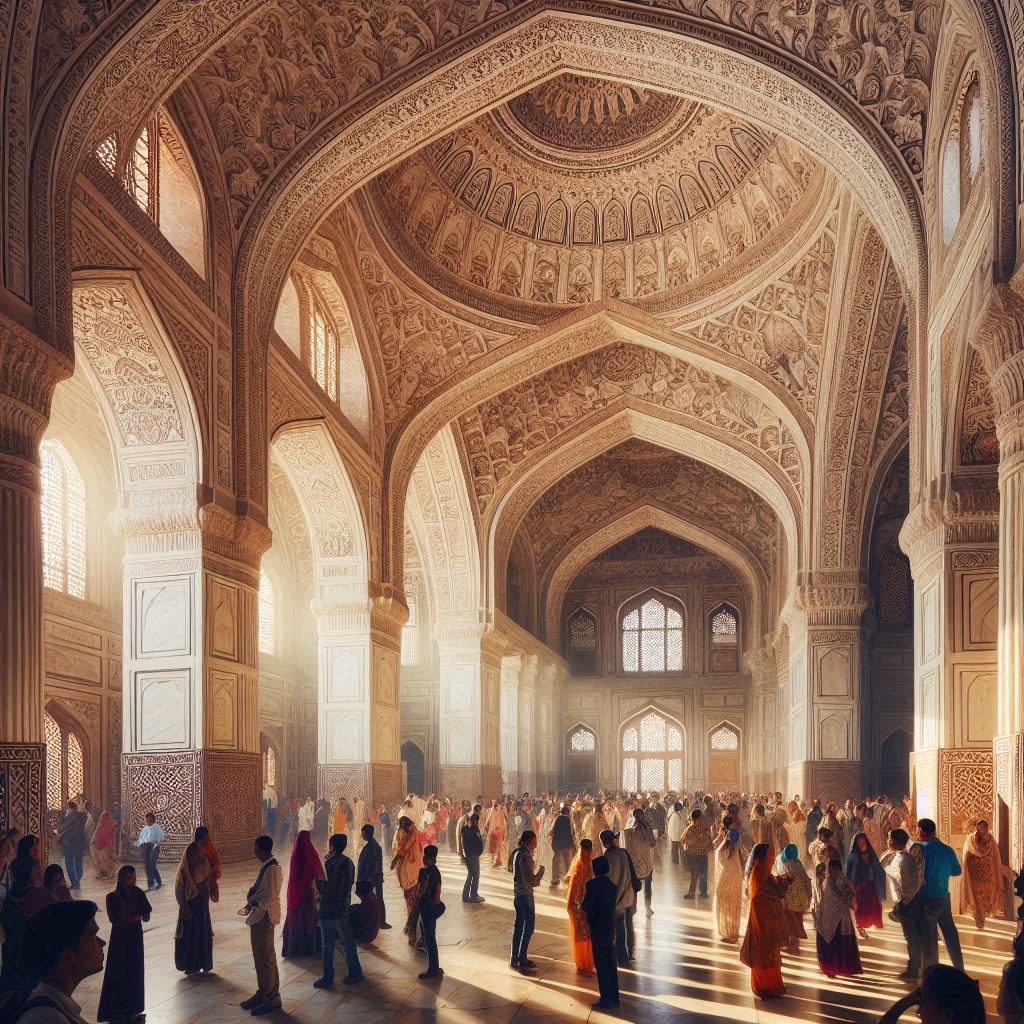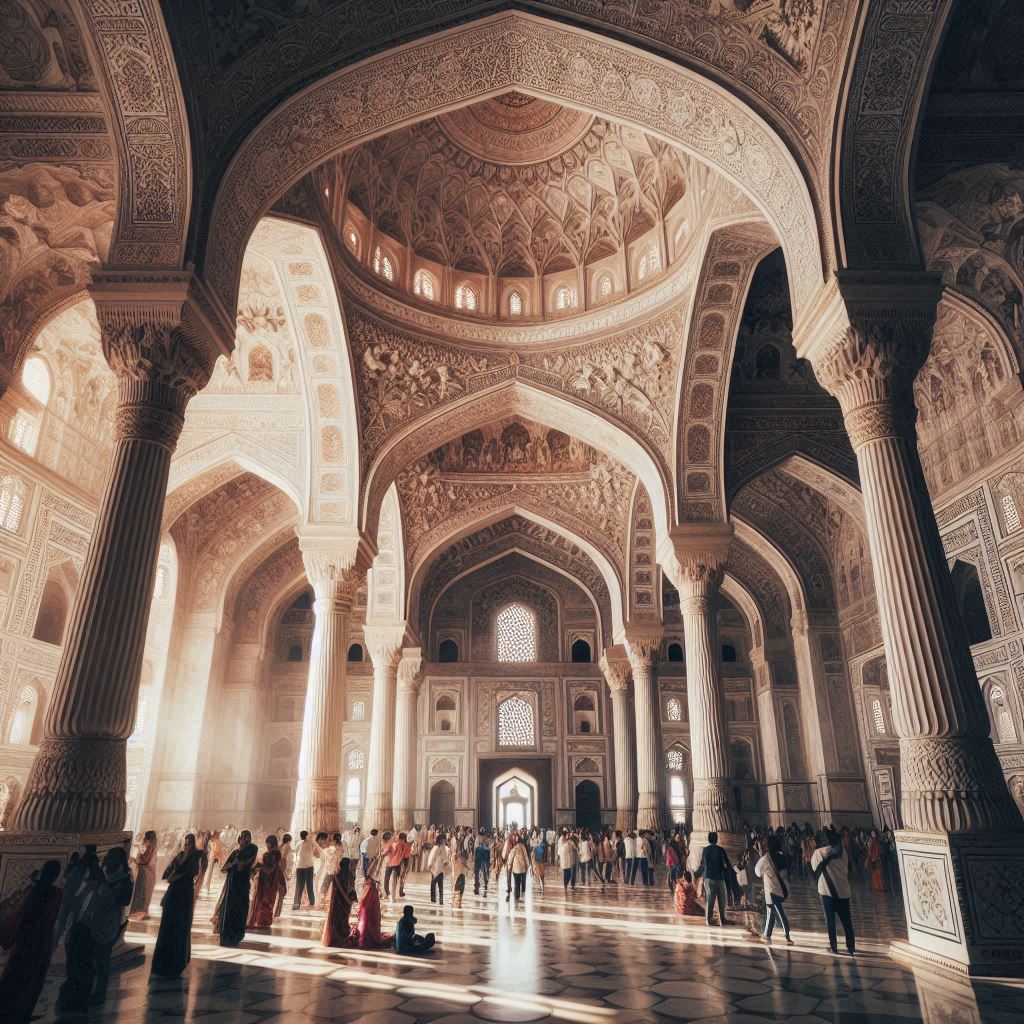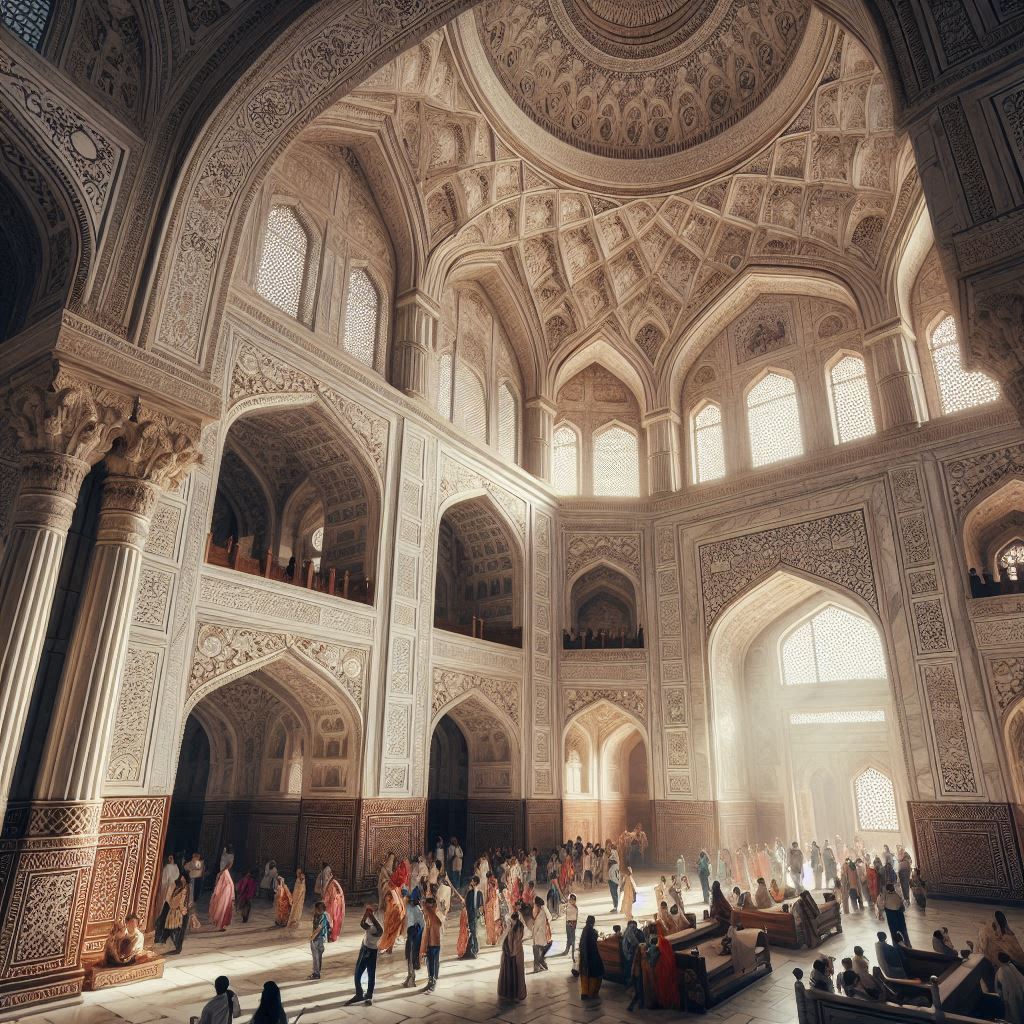Table of Contents
ToggleThe inside of the Taj Mahal
Alone on the Yamuna River shores in Agra, India, the Taj Mahal represents love and a great work of architecture. While the outside has seen millions in awe, the inside of the Taj Mahal has other secrets and marvels. Ladies and gentlemen, joining this article is a virtual sighting of the beauty inside this royal tomb, plus the features of the art work, historical background, and societal aspects it carries with it.

The Grand Entrance
When you enter the Taj Mahal’s interior, the feel is somewhat different. You can sense the marble floor beneath your feet, and the sound of steps is muffled. Doors are never ordinary at Southbank; messages from on high are inscribed in Arabic on the black metal—verses from the Quran.
The Central Chamber
Essentially, the inside of the Taj Mahal is centered on a central tomb, a grave, and the cenotaph of Shah Jahan and Mumtaz Mahal. These Baroque copies of actual burial chambers below are enclosed by a truly marvelous marbled eight-sided partition with superb detailing on the further eight sides, which clearly indicates the craftsmanship of the local skilled workers in the 17th century.
The craft of inlay work and the usefulness and method of preparing and fixing precious stones.
It may perhaps be stated that one of the most prominent characteristics inside the Taj is the walls of pietra dura paneling. Semiprecious stones like lapis lazuli, jade, crystal, turquoise, and amethyst are decorated with deep and beautiful floral motives that one can hardly distinguish when filtering through the lights and actually seeing in the white marble.
The Acoustics Marvel
Talk in a low tone a prayer at the inside of the Taj Mahal; much to your astonishment, you would find it echoing. The dome’s impeccable acoustics give the audio a rather magical feel by boosting whispers and all sorts of other gentle sounds.
Hidden Symmetry
Finally, let us turn to the inside of the Taj Mahal, and it will be seen that never in any country could a more complete example of applying the principles of symmetry could be found. Even the doors and decorations are located in such a way that everything seems to be symmetrical and religiously positive to the eyes.
The Royal Mosque
Toward the west of the fundamental catacomb is the regal mosque, which uncovers the specificities of the Mughal administration’s strict life. Dissimilar to the principal structure, which is made of white marble, this piece of the structure is made of red sandstone.
The Mehman Khana
Adjacent to the entrance from the eastern side inside the Taj Mahal, there is a Mehman Khana, or guest house, to receive guests. This building, like the mosque, was employed to entertain important guests and is a noteworthy part of the complex’s tandem design.
Calligraphy and Islamic art
Carvings of Arabesque forms can also be seen up to the ceiling inside the Taj Mahal, and so is the calligraphy art. Kufic numeral 1022, elegant Quranic calligraphy, and Persian poetry inscriptions from Shah Jahan’s manuscript of the Quran, Shams al-ma’arif, executed by Mir Kalan, are worked into the ornamentation.

The lower chambers
Though they do not form part of the central hall, the graves of Shah Jahan and Mumtaz Mahal are located in the understructure, which is not open to the public. Although the decoration here does not look as bright as the previous rooms, it contains a true philosophical outlook on the monument.
Lighting and Ambiance
This is due to the controlled natural lighting inside the Taj Mahal building; the darkness and lighting change throughout the day. Through openings in roofs and walls, the sun creates plays of light and shade that benefit the warm and mysterious look of the houses.
Nearby Places to Explore
After marveling at the inside of the Taj Mahal, visitors can explore other nearby magnetisms:
- Agra Fort: This is a world heritage site and one of the finest examples of red sandstone architecture. It has a viewpoint of the Taj Mahal.
- Fatehpur Sikri: This abandoned city of the Mughal Territory has inspirational architectural designs for any history lover or architect.
- Akbar’s Tomb: The tomb of the inordinate Mughal emperor Akbar is in Sikandra, Agra, and it is surely one of the fascinating tourist attractions.
- Mehtab Bagh: These gardens deliver an excellent view of the Taj Mahal from the other side of the river.
- Jama Masjid: That is why one of the biggest mosques in India is built in Agra.
Culinary Delights of Agra
Every visit to Agra is complete with savoring its culinary offerings.
- Petha: A sweet prepared from ash gourd, found in a specific flavor, and originated from Agra.
- Bedai: One of the breakfast specialties is deep-fried bread with potato curry as a side dish.
- Mughlai Cuisine: Mark samples exotic foods such as butter chicken and other forms of Indian dishes, such as biryani and kebabs, from the restaurants.
- Dalmoth: This is a tasty munching combination that you can carry around on your trip to try different foods.
- Agra ka Dalmoth: regional version of the well-known Indian crisp snack, chivda.
Conclusion
The inside of the Taj Mahal is more than what is seen; it is what is felt, or perhaps it is spirituality that lights up the inside. They don’t simply stand before you as history; you live this. The minute carving, the interest in light and shade, and the all-pervading theme of love and grief in the Taj Mahal make the inside a place of marvel.
Taj Mahal continues to be a favorite tourist spot for so many visitors. Whether you are an architecture geek, a history lover, or even a mere lover of beauty, there is beauty inside the Taj Mahal. I know it is true, as it reminds us that creativity, devotion, and the primal desire of love exist within us. When you exit, you do so with memories of the marble and stones, but you also take a piece of the great love story that has enthralled the world for centuries. Truly, the monuments within and around are visual pleasures encased in edifices that last till today—tangible proofs of a love story immortalized in stones and paint—the Taj Mahal.

FAQs
Can I take photographs inside the Taj Mahal?
Though photography is allowed in most of the Taj Mahal complex, it is restricted inside the central building. Photography is allowed on the exterior and in the gardens but not inside the central chamber.
How many hours would it take to visit the monuments on the inside and outside of the Taj Mahal?
On average, this famous attraction can be viewed inside for approximately 2–3 hours, taking into account the visit to the complex. However, it may also mainly depend on the level of interest and effectiveness of the pace at which you traverse through the content.
Can I take a guided tour inside the Taj Mahal?
You can find guides at the entrance, though they are officially recognized and authorized. It is also possible to book different tours in advance using the services of different travel companies. A guide, on the other hand, may be of great importance, especially when explaining the historical background of the monument or its various architectural features.


